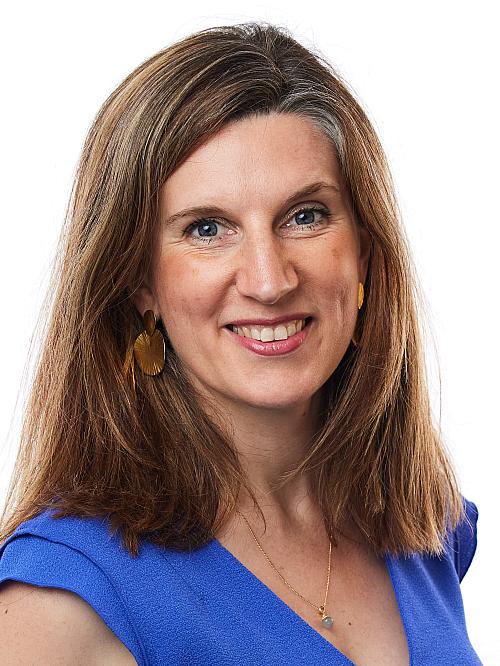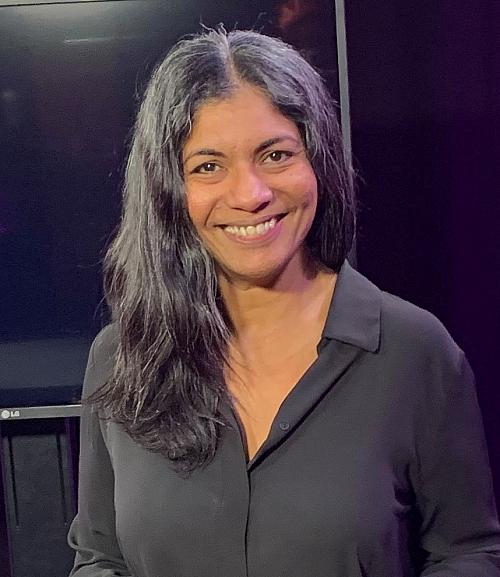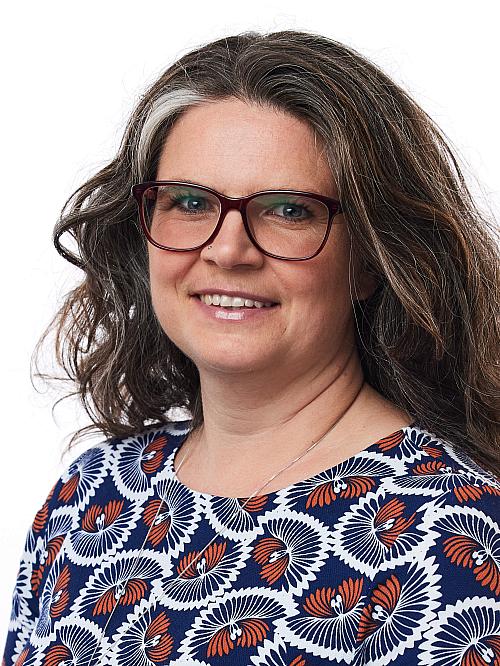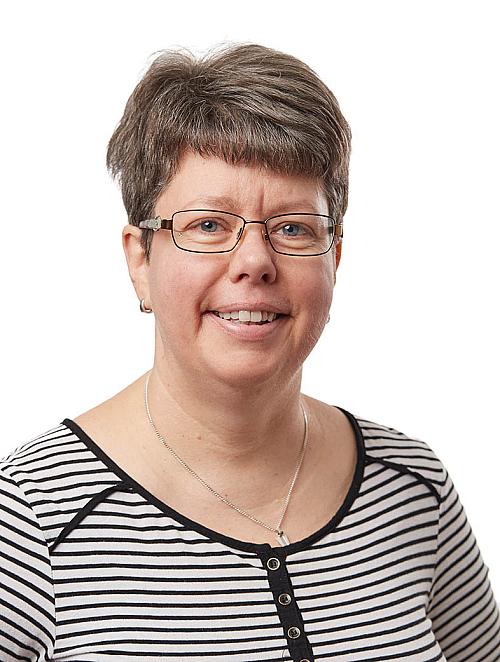Sustainability in Higher Education
At Jönköping University, our vision — "People First" — emphasizes human-centered development. In alignment with the global Sustainable Development Goals (SDGs), this teaching guide aims to inspire and assist our academic staff in integrating sustainability into their teaching across disciplines.
The guide is designed to make sustainable development actionable and engaging for educators and students. It is written in collaboration with teachers from the different schools at JU, to get inspiration and insights from various angles and pespectives.
Teaching for a thriving future
We live in the Anthropocene, a time when human activities are profoundly impacting the planet. Future generations will face climate disruption, degraded ecosystems, and other interconnected challenges. Scientific consensus suggests that limiting global warming to 1.5°C may no longer be achievable without significant changes in how we live, produce, and consume.
Sustainable development has evolved from merely meeting present needs to promoting regeneration — restoring ecosystems and shifting to circular systems. This transformation is urgent but also full of opportunity. The Inner Development Goals (IDGs) offer a framework to cultivate qualities such as humility, compassion, courage, critical thinking, and collaboration — qualities that will help us navigate these uncertain times.
Higher education plays a vital role. As educators at Jönköping University, we have the chance to equip students not only with knowledge but also with the inner resources needed to handle complexity, care for their well-being, and foster communities of trust and resilience. Sustainability should be integrated into all disciplines, not as an addition, but as a lens for transformation. This responsibility is also a source of hope for a thriving future.
We hope this guide will inspire you on that journey.
Sustainability as flourishing with new frameworks and key concepts
At Jönköping University, we recognize that designing societies that support life and well-being for all, including ecosystems, raises more questions than answers. This is an exciting challenge that empowers our students to explore these questions, innovate, and think critically about the interconnectedness of the world.
Our goal is to help students understand the true value and cost of their decisions and how sustainability can flourish. By connecting with global cultures, students can design solutions that span generations. Technology and finance can play key roles in restoring well-being for all forms of life.
Together, we can inspire our students to create a better future, starting with thoughtful questions.
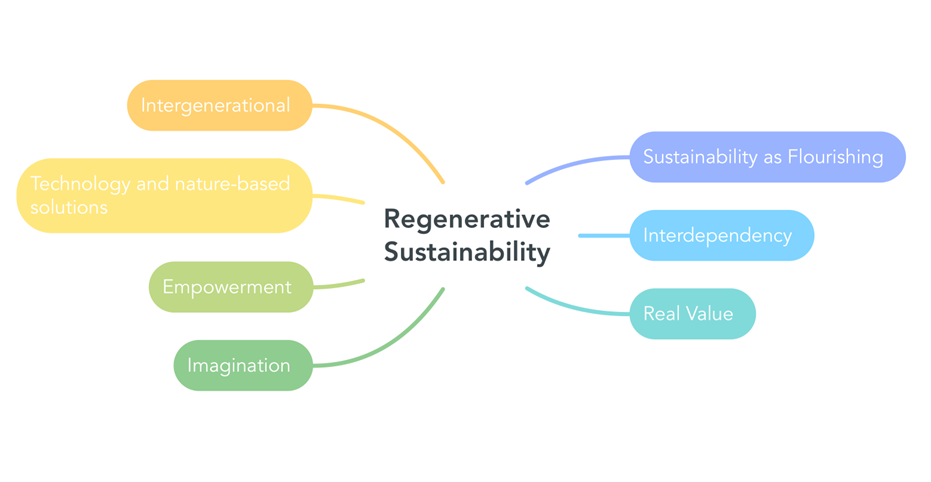
Connecting to our common agenda with the Sustainable Development Goals (SDGs)
The Sustainable Development Goals (SDGs), adopted by all UN member states in 2015, provide a comprehensive framework for achieving a more just, equitable, and sustainable world by 2030. They offer a shared vision for global progress, addressing complex challenges such as poverty, inequality, climate change, environmental degradation, peace, and justice. The SDGs emphasize systems thinking, recognizing the interconnectedness of social, economic, and environmental systems.
Aligning Education with the SDGs
Sustainability education should not be seen as separate from the SDGs, but rather as an essential mechanism for achieving them. By embedding the SDGs into curricula, we can provide students with the knowledge, skills, and ethical frameworks they need to take meaningful action toward these global goals. Integrating the SDGs into teaching offers students a global perspective on local challenges and encourages them to think critically about how their actions can contribute to global solutions.
Suggestions for Integrating SDGs into Teaching:
- Use Real-World Case Studies: Bring in examples of initiatives or case studies directly tied to the SDGs. For example, studying how cities are working to achieve SDG 11 (Sustainable Cities and Communities) through green infrastructure projects or how local businesses are reducing their carbon footprint in line with SDG 13 (Climate Action). Case studies provide concrete illustrations of how global goals are being pursued locally, offering students practical insights into problem-solving and innovation.
- Promote Critical Reflection on SDG Interconnections: Encourage students to consider how multiple SDGs are interconnected, for instance, how SDG 1 (No Poverty), SDG 5 (Gender Equality), and SDG 10 (Reduced Inequalities) are intertwined, and how progress on one can support progress on others. This helps students understand the complexity of sustainability and the need for integrated solutions.
- Create Action-Oriented Projects: Align student projects with specific SDGs. For example, students could work on projects related to SDG 12 (Responsible Consumption and Production), such as reducing waste on campus or organizing a recycling campaign. These action-based projects not only encourage practical engagement but also help students develop the action competence needed to create real change in society.
Connecting to our planetary boundaries & the collective goal of remaining below 1.5 degree target
We have the opportunity to educate our students about the importance of staying within our planetary boundaries and limiting global warming to below 1.5 degrees Celsius. The Stockholm Resilience Centre's research on planetary boundaries highlights the critical thresholds we must respect to maintain Earth's stability and resilience. Additionally, the IPCC reports emphasize the urgent need to limit temperature rise to avoid severe impacts on ecosystems, biodiversity, and human well-being.
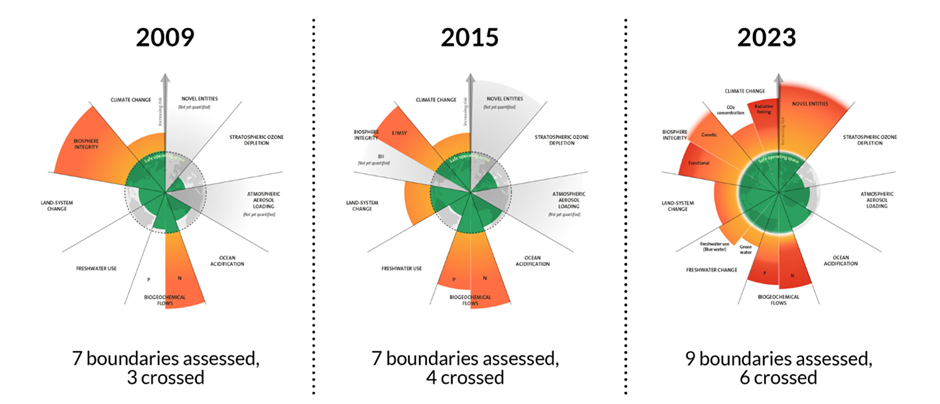
By integrating these insights into our teaching, we can inspire students to understand the interconnectedness of our planet and the significance of sustainable practices. Let's empower them to become informed and proactive leaders who are committed to creating a sustainable future for all forms of life.
References
Intergovernemental Panel on Climate Change https://www.ipcc.ch
Richardson et al. 2023, Steffen et al. 2015, and Rockström et al. 2009) https://www.stockholmresilience.org/research/planetary-boundaries.html
Replacing life at the center of our education with the doughnut economics framework (including our planetary boundaries)
We can also introduce our students to the transformative Doughnut Economics framework. Developed by economist Kate Raworth, this model provides a visual framework for sustainable development, combining the concepts of planetary boundaries and social foundations.
The Doughnut consists of two concentric rings: an ecological ceiling, which ensures we do not exceed the Earth's environmental limits, and a social foundation, which guarantees that everyone has access to life's essentials.
By teaching Doughnut Economics, we can help students understand how to balance human needs with the planet's capacity. This framework encourages us to create a safe and just space for humanity, where we can thrive without compromising the health of our ecosystems. It aligns perfectly with our mission to educate future leaders who are committed to sustainability and well-being for all forms of life.
Let's inspire our students to think critically about their role in shaping a sustainable future and to use the Doughnut Economics framework as a guide for creating equitable and resilient societies.
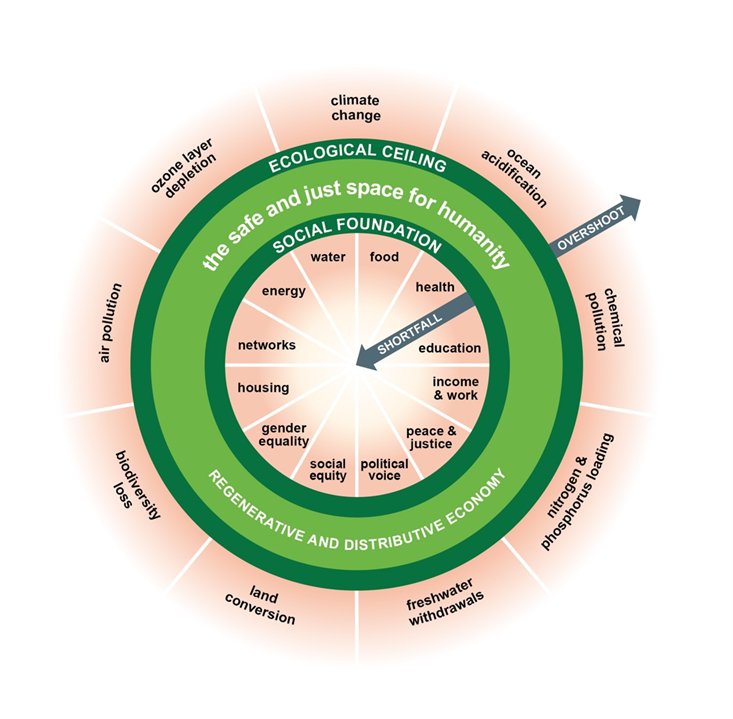
Shifting from Linear to Circular Thinking
Traditional linear thinking often frames production and consumption as a one-way process: resources are extracted, used, and then discarded as waste. This approach has contributed to the depletion of natural resources, increased waste, and environmental degradation. In contrast, circular thinking offers a transformative approach to sustainability. Instead of a "take-make-dispose" model, the circular economy emphasizes a regenerative system where resources are continuously reused, recycled, and restored, minimizing waste and reducing the need for new raw materials.
This shift is not just about changing the way products are designed or managed but also about fundamentally changing how we think about systems, value, and progress. It challenges the conventional view of growth and encourages us to see value in restoration, reuse, and regeneration—recognizing that waste is not inevitable, but a resource to be recovered.
Suggestions for Implementing Circular Thinking:
- Design for Longevity: Encourage students to think about product life cycles, focusing on how products can be designed for repair, reuse, and recycling. Discuss concepts like design for disassembly or modular design that allow products to be easily repaired or repurposed.
- Explore Closed-Loop Systems: Introduce students to examples of closed-loop systems, where waste from one process becomes input for another. For example, urban agriculture could recycle organic waste into fertilizer or energy, demonstrating how the boundaries between waste and resources can blur.
- Promote Circular Business Models: Examine businesses that are adopting circular economy principles, such as product-as-a-service models (where goods are leased rather than sold), or companies that offer product take-back schemes for recycling and reuse. Students can analyze these models and think creatively about how circular approaches can be applied in various industries.
- Foster Systems Thinking: Circular thinking requires an understanding of complex systems and how different components interact. Encourage students to explore the broader impacts of their choices, such as the environmental consequences of consumer goods, and examine the interconnections between ecological, social, and economic factors.
Some examples of facts to discuss in class:
- We use 60% more resources than the Earth can regenerate every year. At this rate, we will need 3 Earths by 2050.
- It takes, on average, 2700 liters of water to create only one T-shirt. What can we do? How can we re-think our processes and move away from this take-make-waste culture that is driving our society to multiple long-lasting crises?
More theory:
Based on Potting et al. (2017), the circular economy 9Rs offer an action-oriented model for resource use: Refuse, Rethink, Reduce, Reuse, Repair, Refurbish, Remanufacture, Repurpose, Recycle, Recover
This framework is particularly useful for encouraging systems thinking and material footprint awareness.
The circular economy (CE) is a framework of 3 principles driven by design:
- ELIMINATE waste and pollution
- CIRCULATE products and materials
- REGENERATE nature
The most common and highly popular reference to CE is and has been the Ellen MacArthur Foundation.
Our students’ inner development and key competencies
No one can solve the challenges that the world faces in isolation – all members of society have a shared responsibility to support all necessary actions.
The Inner development goals, The IDG´s
Inner development is the ongoing growth of human cognitive, emotional, and interpersonal capacities — often cultivated through relationships and oriented toward service to the world.
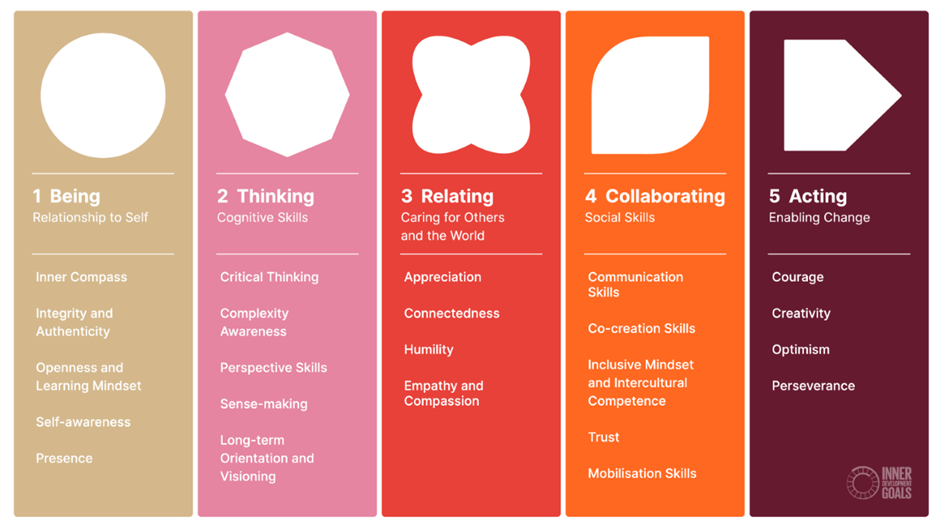
The IDG framework identifies five interrelated dimensions:
- Being – relationship to self
- Thinking – cognitive skills
- Relating – caring for others and the world
- Collaborating – social skills
- Acting – driving change
Integrating IDGs into teaching encourages students to connect learning to self-awareness, compassion, creativity, and ethical action.
Easy practices at the start of a workshop:
- Time length: 12minutes
- Introduction: The teacher invites all to start walking in the room. Participants are encouraged to greet each other, look in the eyes and greet, be curious, and go beyond the awkward feelings.
- Invitation from the teacher: At some point the teacher stops the group and asks each person to pair with one another.
- Tip: To avoid wasting time figuring out who will start talking first, a fun clue should be given by the teacher, such as “the student with the longest hair asks the other” or “the one who celebrated its birthday last will start talking” or “the one who last finished reading a book starts asking”.
- Questions to be explored (create your own):
- A simple question will then be asked such as:
- “How are you today?”
- “What is currently challenging in your life?” or another question of your choice that helps create an opportunity to get to know each other through practising active listening
- Active listening:
- The students then practice active listening for 4 minutes (2 minutes for each person to listen/talk)
- The teacher tells the participants when 2 minutes have passed so that they can swap roles.
- Gratitude and regaining their sits:
- Students thank each other, regain their sits and smile; they feel more connected and seen, which increases self-awareness, too.
- Debriefing:
- The teacher can explain how practising this helps the students connect with different human qualities that are relevant in the course context.
Eight key competencies needed for sustainable development:
Competence in sustainability is not just about knowing — it’s about doing. UNESCO (2017) outlines eight key competencies needed for sustainable development:
- Systems thinking
- Anticipatory thinking
- Normative competence
- Strategic competence
- Collaboration
- Critical thinking
- Self-awareness
- Integrated problem-solving
UNESCO (2017) has identified eight different competences deemed necessary for students to contribute to societal change to achieve the global sustainability goals. Competence here refers to "the specific attributes individuals need for action and self-organization in various complex contexts and situations” (p. 10).
These include: the ability to think systemically (analyze complex systems); the ability to anticipate different possible futures and to create visions for the future; normative competence (the ability to understand and reflect on the norms underlying one's actions); strategic competence (the ability to collaborate with others to develop and implement measures that promote sustainability locally or globally); collaborative competence; and critical thinking skills. Additionally, these competences include self-awareness and problem-solving ability (UNESCO, 2017, p. 10).
Students with different backgrounds and in different educational programs may need to develop different competencies (Sterling, 2010).
Recently, the concept of action competence has gained more attention in research. Action competence originated in environmental and health education in Denmark in the 1990s and has been defined as relevant knowledge, will, and confidence in one's own ability (self-efficacy) to contribute to solving controversial issues (Jensen, 2000; Mogensen & Schnack, 2010; Sass et al., 2020).
The concept of action competence, originally developed in Denmark, highlights the integration of:
- Relevant knowledge
- Willingness to act
- Confidence in one’s ability (self-efficacy)
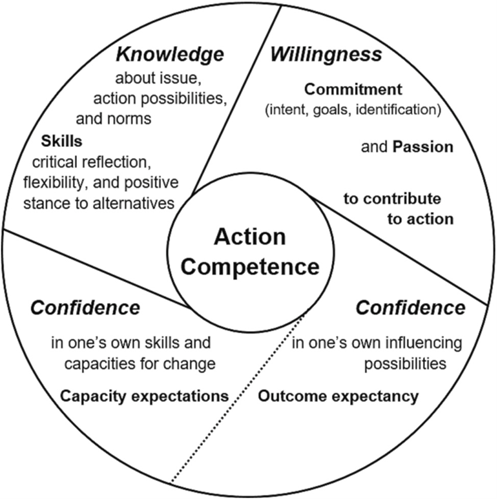
In the OECD report "Empowered Citizens, Informed Consumers and Skilled Workers" (2025), skills requirements for the green transition are listed:
- Technical skills; such as proficiency in production processes, machine operations, and other specialised tasks vital to a particular field or industry.
- Transversal skills; can be applied across various jobs, industries, or situations. Examples include communication, teamwork, problem-solving, adaptability, and leadership.
- Sustainability competencies: include a strong grasp of the interconnection between social and ecological systems; critical, creative, and systems thinking; as well as a willingness to act and collaborate with others in shaping a sustainable future.
Teaching Examples from JU and beyond, that move the audience beyond passive learning toward active engagement and social transformation:
- The relationship between humans and nature: A study from a master’s program at Lincoln University, New Zealand, examined which elements of a course titled "Aspects of Sustainability: An International Perspective" most influenced master's students' views on the relationship between humans and nature, and their action competence (Piasentin & Roberts, 2018). The course was divided into four different parts. The first part focused on the sustainability challenges humanity faces ("What are the problems?"), and the second on the underlying causes of these problems ("Why do we have these problems?"). Parts three and four were more action-oriented, exploring the questions "How do we change?" and "Where do we want to go?". The teaching combined traditional pedagogy with lectures, films, and class exercises with "more transformative pedagogy" (p. 699) to stimulate collaboration, reflective learning, and action competence. The course content was based, among other things, on The Natural Step's sustainability principles (www.detnaturligasteget.se). Students were asked to reflect continuously on their own attitudes and learning. The evaluation showed that students, after completing the course, were more convinced of the necessity of sustainable development and had gained greater awareness of local sustainability issues. Some students had also changed their view on the relationship between humans and society and strengthened their confidence in being able to act for a sustainable future. The elements of the course that most affected students were class discussions, a debate on green growth, a reflection on the meaning of happiness, experiences conveyed during lectures, and the feedback they received on their weekly reflections (Piasentin & Roberts, 2018).
- Mindfulness & Biodiversity (University of Wisconsin): Students reflected on their ecological footprint, connected learning to personal habits, and participated in local conservation projects. Sustainability Perspectives (Lincoln University): Structured around “What’s wrong?”, “Why?”, “How do we change?”, and “Where do we go?”, with strong emphasis on reflection and debate.
- JU Examples:
- At HLK Global Studies, students surveyed local attitudes and practices around sustainable fishing.
- At HLK, a project about Action competence for sustainable development was conducted. The project investigated how action competence for sustainable development can be developed in schools and preschools.
- At HLK, in the teacher education biology course, students examined a local infrastructure project’s effect on aquatic biodiversity.
- JIBS Responsible Enterprise offers the opportunity for students to greet each other and ask deep questions while practising active listening at the beginning of their seminars
- JIBS Accelerating a sustainability transition invites its participants to take a mindful walk outdoors and practice nature enquiries.
References
Batsa, A.S., Li, S. & Khajuria, A. (2025) Action Competence in Sustainable Development (ACiSD): A systematic review of the contributing factors and learning strategies. International Journal of Development and Sustainability, 14(1):29-70.
Going deeper 2023 Inner development goals. https://drive.google.com/file/d/1M3e1ixgNRXXrlFIN93M2WMmApQwDB9MC/edit; 2023.
Inner Development Goals. Transformational Skills for Sustainable Development [Available from: https://innerdevelopmentgoals.org/.
Jensen, B.B. (2000). Health knowledge and health education in the democratic health-promoting school. Health Education, 100(4):146–154. https://doi.org/10.1108/09654280010330900
Mogensen, F., & Schnack, K. (2010). The action competence approach and the ‘new’ discourses of education for sustainable development, competence and quality criteria. Environmental Education Research, 16(1):59–74. https://doi.org/10.1080/13504620903504032
Moyer-Horner, L., Kirby, R. & Vaughan, C. (2010), Education as a tool for addressing the extinction crisis: Moving students from understanding to action. Revista de Biologia Tropical, Vol. 58(4): 1115-1126.
Piasentin, F.B. & Roberts, L. (2018) What elements in a sustainability course contribute to paradigm change and action competence? A study at Lincoln University, New Zealand. Environmental Education Research, 24 (5):694-715
United Nations. Transforming our world: The 2030 agenda for sustainable development. 2015.
Inner development goals. Transformational skills for sustainable development. https://drive.google.com/file/d/1L-t4CEWQ1APfJcXT44KEByaXsRz_J4jD/view.
Sass, W., Boeve-de Pauw, J., Olsson, D., Gericke, N., De Maeyer, S. & Van Petegem, P. (2020) Redefining action competence: The case of sustainable development, The Journal of Environmental Education, 51(4): 292-305, DOI:10.1080/00958964.2020.1765132
Sterling, S. (2001). Sustainable Education – Re-visioning Learning and Change, Schumacher Briefing no6. Dartington: Schumacher Society/Green books
Sterling, S. (2010). Transformative Learning and Sustainability: Sketching the Conceptual Ground. Learning and Teaching in Higher Education 5:17-33
Sterling, S. (2021) Educating for the Future We Want. Opening essay for GTI Forum “The Pedagogy of Transition,” Great Transition Initiative.
UNESCO (2017) Education for Sustainable Development Goals. Learning objectives. https://doi.org/10.54675/CGBA9153
OECD (2025), Empowered Citizens, Informed Consumers and Skilled Workers: Designing Education and Skills Policies for a Sustainable Future, OECD Publishing, Paris, https://doi.org/10.1787/311cdbeb-en.
The wellbeing and cognitive benefits of incorporating outdoor, nature-based sessions
Incorporating outdoor, nature-based experiences into higher education is essential for fostering a deeper, embodied understanding of sustainability.
Beyond cognitive knowledge, students must be given opportunities to feel, reflect, and connect with the living systems they study. As the Earth Charter reminds us, "We must realize that when basic needs have been met, human development is primarily about being more, not having more" (Earth Charter principle 4, online, 2025).
Nature offers a profound context for such growth—encouraging presence, humility, and care. Experiential pedagogies, such as those explored in Into the Wild: Pedagogical Innovation for Responsible Management (Nonet, 2013), show how stepping outside the classroom can catalyze a shift from abstract thinking to personal transformation. In these immersive settings, students reconnect with their values, develop ecological consciousness, and experience interdependence firsthand. As institutions aim to educate for sustainability and responsible leadership, enabling students to spend time outdoors—to sense, pause, and be—becomes not an extra, but a pedagogical imperative.
References
Earth Charter Commission. (2000). The Earth Charter. Earth Charter International. https://earthcharter.org/read-the-earth-charter/ Accessed online April 8, 2025.
Nonet, G. (2013). Into the wild: Pedagogical Innovation for Responsible Management - Rotterdam School of Management - Erasmus University, In: Inspirational Guide for the Implementation of PRME (Principles for Responsible Management Education) Second Edition: Learning to go Beyond. Sheffield: Greenfield Publishing, ISBN-978-1-906093-13-6, pp.69-74.
Interdependency: Making Sense of Systemic and Multi-Stakeholder Nature
Sustainability issues are inherently complex, often involving multiple stakeholders with different, sometimes conflicting, perspectives. To help students understand this complexity, it's crucial to engage them in practical, hands-on learning. Role-play activities are a powerful tool for this purpose.
Several studies (Mehta, 2023; Paschall & Wüstenhagen, 2012; Surendran et al., 2023) highlight the effectiveness of role-playing in teaching sustainability. These activities immerse students in real-world scenarios where they must negotiate, take on different roles, and explore diverse perspectives.
For example, role plays about establishing a mine or participating in United Nations climate negotiations (COPs) introduce students to the viewpoints of multiple stakeholders, such as local communities, mining companies, governments, and environmental organizations.
By stepping into these roles, students gain a deeper understanding of the interconnections and complexities inherent in sustainability challenges.
Embracing the wicked and systemic dimensions
Sustainability issues are often called "wicked problems" — since they are complex, interdependent, and resistant to simple solutions.
Key features for wicked problems include:
- Scientific uncertainty
- Ethical and political controversy
- No clear endpoint or consensus
- Multiple competing values and perspectives
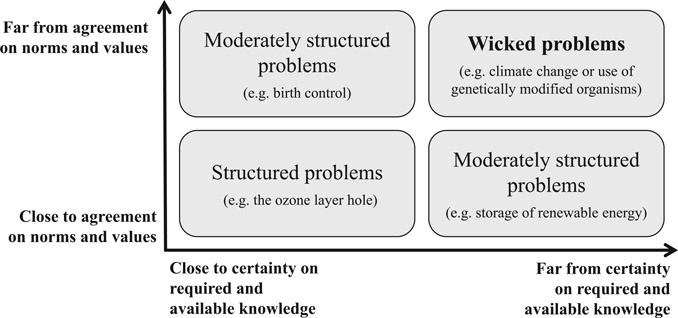
Teaching students to work with uncertainty and ambiguity and to explore ethical dilemmas through participatory methods is essential for sustainable learning.
Suggested Activity:
Personal connection with the meaning of “systemic” and “wicked”
Tracing the Web – Seeing the System Behind the Everyday
- Objective:
To help students develop a personal and embodied understanding of what makes a sustainability issue systemic and wicked by reflecting on the invisible interconnections behind everyday items like food, water, or clothing. - Instructions:
Invite students to take a reflective pause during a course break or in the evening at home. Ask them to look mindfully at something they are about to consume or use—a meal, a glass of water, the T-shirt they are wearing. - Then, pose these guiding questions:
- Where did it come from?
- What country or region produced it?
- How far did it travel to reach me?
- What systems made it possible?
- Who grew, produced, processed, or transported it?
- What technologies, chemicals, or materials were used?
- What dependencies are hidden in this object?
- How does it depend on climate, global trade, market pricing, or geopolitical events?
- How are farmers, workers, transporters, and retailers affected?
- Who else is impacted?
- What about waste, pollution, labor rights, biodiversity?
- Who benefits? Who bears the cost?
- What dilemmas arise?
- Is there a clear “right” choice?
- How does this object reflect tensions between convenience, ethics, health, and economy?
- Debrief in class:
Bring students together in small groups or a circle dialogue format. Invite them to share what came up in their reflection. What systems became visible? Where did they see wickedness—conflicting interests, uncertainty, or ethical tensions? - Learning Outcome:
Students will begin to feel and articulatethe web of interdependencies and uncertainties that define “systemic” and “wicked” sustainability problems. This creates a foundation for deeper engagement with systems thinking and ethical complexity in sustainability education.
Once the students have done this exercise with a personal item, it will be easier for them to apply the same principles to a product, a company, or an industry.
Choose a sustainability challenge (e.g., fast fashion, energy transition) and ask students to identify key stakeholders, their motivations, and potential conflicts.
Use systems thinking tools like causal loop diagrams or mind mapping to visualise the complexity of the problem.
References:
Mehta, S., Hingle, A., & Johri, A. (2023). Teaching Sustainability Through A Role-Play Case Study Of E-Scooter Use On College Campuses. European Society for Engineering Education (SEFI). DOI: 10.21427/EZXC-6M65
Paschall, M., & Wüstenhagen, R. (2012). More Than a Game: Learning About Climate Change Through Role-Play. Journal of Management Education, 36(4), 510-543. https://doi.org/10.1177/1052562911411156
Surendran, S., Mack, K., & Mistry, A. (2023). Bring the SDGs into the classroom through role play and gamification. Times Higher Education. https://www.timeshighereducation.com/campus/bring-sdgs-classroom-through-role-play-and-gamification
Swedish United Nations Association. (2016). Climate change role play. https://fn.se/wp-content/uploads/2016/08/climate_role_play.pdf
Van Poeck, K., Östman, L. & Öhman, J. (2019). Tackling wicked problems in teaching and learning. Sustainability issues as knowledge, ethical and political challenges. Sustainable Development Teaching: Ethical and Political Challenges. London: Routledge, pp.28-39. https://doi.org/10.4324/9781351124348
Hanson, L.L. (2019). Wicked Problems and Sustainable Development.In: Leal Filho, W. (eds) Encyclopedia of Sustainability in Higher Education. Springer, Cham. https://doi.org/10.1007/978-3-319-63951-2_522-1
Intergenerational & multi-perspective education
Intergenerational strategies are essential for creating strong, resilient communities that can adapt to changing conditions and ensure long-term well-being.
By incorporating these perspectives into our teaching, we can help students appreciate the value of different experiences and viewpoints.
This approach fosters a deeper understanding of the interconnectedness of our world and the need for inclusive, sustainable solutions.
Let's inspire our students to become leaders who can bridge generational gaps and collaborate across diverse backgrounds to create a thriving future for all.
Suggested Class Activity:
Intergenerational Dialogue Workshop
- Preparation: Invite guest speakers from different generations and backgrounds to share their experiences and perspectives on sustainability and regenerative practices.
- Group Discussions: Divide students into small groups, ensuring a mix of ages and backgrounds. Each group discusses specific sustainability challenges and potential solutions, drawing on the diverse perspectives within the group.
- Presentation: Each group presents their findings and proposed solutions to the class, highlighting the benefits of incorporating intergenerational and multi-perspective approaches.
- Reflection: Conclude with a class discussion on the insights gained from the activity and how these can be applied to future projects and initiatives.
This activity not only promotes intergenerational understanding but also encourages students to think critically and collaboratively about creating a sustainable future.
Empowering our students
Students today are not just passive recipients of information; they are active participants in shaping the world around them. By empowering students to take ownership of the SDGs and act as change-makers, we help them develop a sense of agency and responsibility toward sustainable development. This is a vital aspect of fostering competence in sustainability that will allow them to navigate the challenges ahead.
Student-led projects foster engagement and apply learning in real contexts. At JU, Students for Sustainable Action (SSA) is a dynamic group promoting change on campus through:
- Clothing swap days
- Campus gardening
- Climate Month events
- Menstrual product accessibility
- Advocacy for vegetarian options, healthier food on campus and better waste systems
These activities exemplify action competence in practice. Teachers are encouraged to connect coursework with these efforts and support students in taking initiative.
Suggestions for Empowering Students:
- Facilitate Student-Led SDG Initiatives: Encourage students to lead their own sustainability initiatives, whether on campus or within their communities. These initiatives can directly address specific SDGs, such as organizing a food waste reduction campaign (SDG 12) or promoting renewable energy solutions (SDG 7). By taking action, students gain confidence in their ability to drive change and develop the skills necessary for leadership.
- Encourage Student Advocacy: Give students a platform to advocate for SDGs within the university and beyond. This could involve organizing petitions, holding discussions on sustainable policies, or presenting proposals to the university administration on how to make the campus more sustainable. This not only empowers students but also helps foster a culture of student-led advocacy and civic engagement.
- Support Cross-Campus Collaborations: Foster collaboration among different departments and student groups on sustainability projects. For example, a partnership between engineering, environmental studies, and business students can lead to innovative solutions for reducing energy consumption on campus. Cross-disciplinary collaboration provides students with a holistic understanding of sustainability and prepares them for the complexity of real-world problems.
Technology and nature-based solutions
In addressing the pressing sustainability challenges of our time, it’s crucial to recognize the potential of blending technology with nature-based solutions. By merging cutting-edge innovations with a deep respect for natural and human systems, we can create holistic, transformative approaches that not only address environmental concerns but also promote human well-being. This intersection between innovation and ecological wisdom empowers us to solve complex challenges in a way that is both sustainable and impactful.
Examples of blending technology with nature-based Solutions:
- Jönköping University Solar Team (JUSolar Team): At Jönköping University, students are leading the way in the renewable energy revolution through the JUSolar Team. This student-driven initiative focuses on creating solar-powered vehicles that push the boundaries of sustainable transport. By using advanced solar technology, the team is not only contributing to reducing carbon emissions but also demonstrating how technological innovation can be integrated into real-world sustainability solutions. Their work highlights how students can combine engineering skills with environmental stewardship to make tangible contributions to a more sustainable future.
- Using Drones for Replanting Forests: Drones and AI have become innovative tools in the battle against deforestation and climate change. By using drones equipped with seed-planting technology, companies and organizations can quickly reforest large, inaccessible areas. This approach allows for rapid restoration of ecosystems, mitigating the effects of deforestation and helping combat biodiversity loss. Standford University, USA has established several inititatives blending nature based solutions and high technologies. Stanford Woods Institute for the Environment collaborates with AirSeed Technology on this matter.
- Artificial Intelligence (AI) for Human Well-being: AI can improve health outcomes by predicting disease outbreaks, improving medical diagnoses, and enhancing personalized treatment plans. The University of Oxford hosts the Oxford Internet Institute (OII), which combines AI and social science to improve societal well-being. Applications are developed to understand and predict mental health conditions, allowing for earlier intervention and better patient care.
By incorporating AI into sustainability education, students can explore how these technologies work in synergy with human and ecological systems, providing solutions that are both innovative and ethical.
Encouraging Creative and Synergistic Thinking in Sustainability Education:
By encouraging students to think creatively and synergistically, educators can help them understand that the future of sustainability lies not in choosing between technology and nature but in finding innovative ways to combine the two. Technology can help solve complex global challenges, but it must be used in a way that respects and enhances the ecological systems we depend on. Exposing students to these diverse solutions allows them to see the interconnectedness of all systems—technological, natural, and human—and how they can work together to build a sustainable, thriving world.
References
Jönköping University Solar Team https://www.jusolarteam.se/
Oxford Internet Institute https://www.oii.ox.ac.uk/
Stanford Woods Institute for the Environment https://woods.stanford.edu/
Final Reflections
Teaching for a thriving future is not simply about adding new content to the curriculum. It's about reimagining how and why we teach, focusing on the purpose of education itself. Educators must cultivate not only knowledge but also the skills, values, and dispositions that empower students to engage with the well-being of all living systems. This includes fostering an understanding of complexity, developing ethical action competencies, and encouraging students to leave a restored world for future generations.
To achieve this vision, educators are invited to:
- Have fun and be creative: Reimagining education needs to be inspiring and inviting, fostering an environment that encourages exploration and innovative thinking.
- Reflect on their own inner development: Educators should engage in their own growth processes to better understand the challenges of sustainability and their role in fostering systemic change.
- Spend more time outdoors: Nature-based experiences can provide crucial insights into sustainable living and deepen connections with ecological systems.
- Engage in continuous learning: Take courses, training, and readings to increase understanding of the Earth's current state and how it connects with their field of expertise.
- Design learning that integrates head, heart, and hands: Effective sustainability education connects cognitive knowledge with emotional and practical action.
- Embrace complexity and dialogue: Create classroom environments where diverse viewpoints are encouraged, and inquiry is valued over simple answers.
- Foster a culture of inquiry and collective intelligence: Recognize that we have more questions than answers and encourage students to engage in shared learning, creating a community of thoughtful, collaborative problem-solvers.
- Remember that nobody is an expert on the subject. As a teacher, you get to practise stepping out of your comfort zone and learning together with your students. Building trust in the group and fostering open communication are essential building blocks for success.
Together, we can build a university culture where the design of a thriving life is not just taught—it is lived.
The guide has been developed by Guénola Nonet, Per Askerlund, Johanna Bergström, Vanajah Siva and Petra Wagman, together with Educate.
- Assistant Professor Business Administration
- Jönköping International Business School
- guenola.nonet@ju.se
- Assistant Professor Operations and Supply Chain Management
- School of Engineering
- vanajah.siva@ju.se
- Assistant Professor of Biology
- School of Education and Communication
- per.askerlund@ju.se
- Assistant Professor of Global Studies
- School of Education and Communication
- johanna.bergstrom@ju.se
- Senior Lecturer
- School of Health and Welfare
- petra.wagman@ju.se


